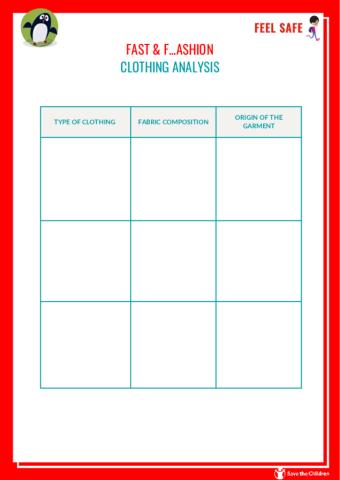Fast & F...ashion
Objectives:
- Understand the life cycle of products and the environmental and social risks associated with it
- Assess the consequences of frequent and unreasonable consumption of clothing
- Recognize the materials used in clothing production and their environmental properties and impacts
Before starting
The teacher starts the discussion on the topic of fast fashion by asking students what reasons influence their clothing purchase choices. Together, the class will create a list of motives. The teacher can prompt them to reflect on aspects such as:
- Trends and fashion
- Influence of word of mouth
- Affordability
- Origin of garments
- Materials used
- Mode of purchase (in store, online, etc.)
After the brainstorming moment, the teacher explains that the term “fast fashion” coined by the New York Times in 1990, refers to the production and sales model characterized by speed and low cost.
The teacher explores the hidden issues behind fashionable garments, pointing out that their low price is often accompanied by poor quality, causing huge amounts of waste and pollution. The sustainability Development that ensures that the needs of the present generation are met without compromising the ability of future generations to meet their own needs promised by fashion industries is often misleading, with devastating environmental and social impacts.
In fact, fast fashion is considered a major contributor to global pollution. This industry consumes huge amounts of water, uses toxic chemicals and generates massive waste.
But how is it possible for a simple T-shirt to cost so little?
The teacher can show this video to guide the discussion:
The road Dress travelled
To increase awareness and involvement, the teacher asks each student to select at least two pieces of their clothing and record the following information on their “Clothing Analysis” (see attached “Fast & F...ashion - Clothing Analysis” below):
- Type of clothing (shirt, shoes, pants, etc.)
- Composition of the garment
- Origin of the garment
After filling out the card, students place their “Clothing Analysis” on a world map.
The teacher then leads a discussion using the following stimulus questions:
- How far does an average T-shirt travel to get to you?
- Why is it best to avoid buying from sites that ship from far away?
- What does the composition of the clothing we choose tell us about the materials we wear every day?
- How is the frequent consumption and purchase of clothing - related to fast fashion - a problem for the climate?
Fast Fashion alert
The teacher shows a selection of photos (see attached “Fast & F...ashion - Photo Gallery” below) that highlight working conditions in factories, the problem of environmental pollution, and the impact of petrochemical-derived textile fibers on our health.
The teacher stimulates discussion by asking questions, such as:
- What has affected you most?
- How can we help change this situation?
At this point, students work in small groups and are given visual materials (catalogs, flyers, e-commerce images, fashion magazines, etc.) of different clothing brands. The task is to identify the hallmarks of fast fashion, focusing especially on the following key factors: styles, delivery time, quantity produced, type of materials.
Each group shares their observations and lists the brands identified as fast fashion, explaining their reasons.
Concluding thoughts
The teacher proposes a final reflection on solutions to limit the damage of fast fashion.
To guide the final reflection, the teacher shares with the class the following vademecum containing some useful tips for more conscious shopping:
- Prefer domestic brands;
- Buy vintage garments;
- Get informed and be more aware before buying clothing;
- Donate unwanted or unused garments (surely there will be people who will appreciate it);
- Observe the label;
- Be more careful when shopping in stores and online, and avoid damaging garments;
- Try to avoid thes following fabrics unless they are needed for a functional purpose (like making your coat waterproof):
Rayon - Spandex - Nylon - Acrylic - Modal - Polyester
They all have a high environmental impact as they are not biodegradable and made from synthetic materials that release microplastics when washed.
- Buy garments made from sustainable fabrics (linen, hemp);
- Buy clothing made from recycled materials

Add new comment